suspension MAZDA MODEL 3 HATCHBACK 2020 Owners Manual (in English)
[x] Cancel search | Manufacturer: MAZDA, Model Year: 2020, Model line: MODEL 3 HATCHBACK, Model: MAZDA MODEL 3 HATCHBACK 2020Pages: 598, PDF Size: 89.37 MB
Page 74 of 598
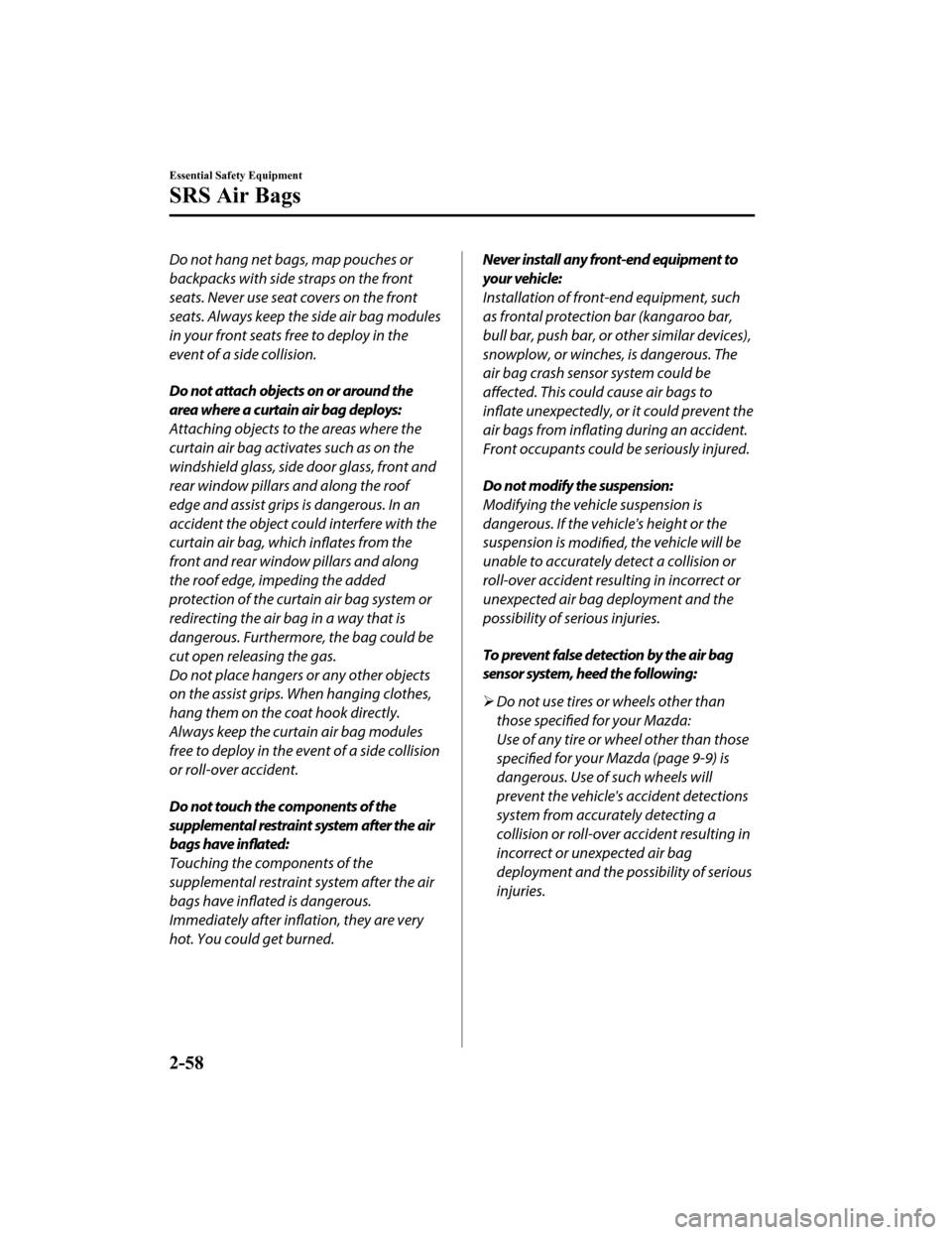
Do not hang net bags, map pouches or
backpacks with side straps on the front
seats. Never use seat covers on the front
seats. Always keep the side air bag modules
in your front seats free to deploy in the
event of a side collision.
Do not attach objects on or around the
area where a curtain air bag deploys:
Attaching objects to the areas where the
curtain air bag activates such as on the
windshield glass, side door glass, front and
rear window pillars and along the roof
edge and assist grips is dangerous. In an
accident the object could interfere with the
curtain air bag, which inflates from the
front and rear window pillars and along
the roof edge, impeding the added
protection of the curtain air bag system or
redirecting the air bag in a way that is
dangerous. Furthermore, the bag could be
cut open releasing the gas.
Do not place hangers or any other objects
on the assist grips. When hanging clothes,
hang them on the coat hook directly.
Always keep the curtain air bag modules
free to deploy in the event of a side collision
or roll-over accident.
Do not touch the components of the
supplemental restraint system after the air
bags have inflated:
Touching the components of the
supplemental restraint system after the air
bags have inflated is dangerous.
Immediately after inflation, they are very
hot. You could get burned.Never install any front-end equipment to
your vehicle:
Installation of front-end equipment, such
as frontal protection bar (kangaroo bar,
bull bar, push bar, or other similar devices),
snowplow, or winches, is dangerous. The
air bag crash sensor system could be
affected. This could cause air bags to
inflate unexpectedly, or it could prevent the
air bags from inflating during an accident.
Front occupants could be seriously injured.
Do not modify the suspension:
Modifying the vehicle suspension is
dangerous. If the vehi cle's height or the
suspension is modified, the vehicle will be
unable to accurately detect a collision or
roll-over accident resulting in incorrect or
unexpected air bag deployment and the
possibility of serious injuries.
To prevent false detection by the air bag
sensor system, heed the following:
Do not use tires or wheels other than
those
specified for your Mazda:
Use of any tire or wheel other than those specified for your Mazda (page 9-9) is
dangerous. Use of such wheels will
prevent the vehicle's accident detections
system from accurately detecting a
collision or roll-over accident resulting in
incorrect or unexpected air bag
deployment and the possibility of serious
injuries.
Essential Safety Equipment
SRS Air Bags
2-58
Mazda3_8HZ1-EA-19G_Edition1_old 2019-5-17 13:49:03
Page 142 of 598
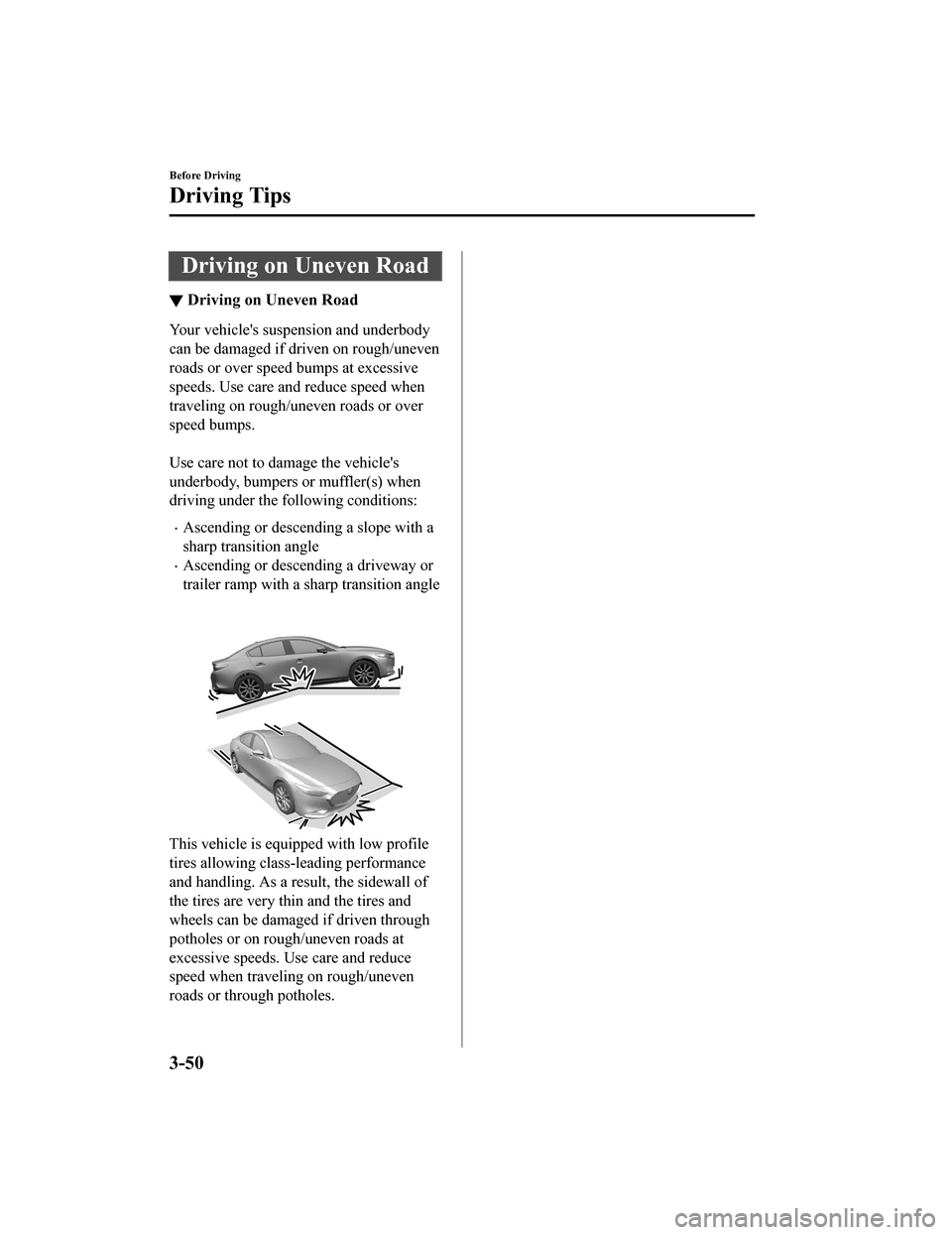
Driving on Uneven Road
▼Driving on Uneven Road
Your vehicle's suspension and underbody
can be damaged if driven on rough/uneven
roads or over speed bumps at excessive
speeds. Use care and reduce speed when
traveling on rough/uneven roads or over
speed bumps.
Use care not to damage the vehicle's
underbody, bumpers or muffler(s) when
driving under the following conditions:
Ascending or descending a slope with a
sharp transition angle
Ascending or descending a driveway or
trailer ramp with a
sharp transition angle
This vehicle is equi pped with low profile
tires allowing class-leading performance
and handling. As a result, the sidewall of
the tires are very th in and the tires and
wheels can be damaged if driven through
potholes or on rough/uneven roads at
excessive speeds. Use care and reduce
speed when traveling on rough/uneven
roads or through potholes.
Before Driving
Driving Tips
3-50
Mazda3_8HZ1-EA-19G_Edition1_old 2019-5-17 13:49:03
Page 235 of 598

WA R N I N G
Do not rely completely on the LDWS:
The LDWS system is not designed to
compensate for a driver’s lack of caution
and relying too much on the system
could lead to an accident.
The functions of the LDWS have
limitations. Always stay on course using
the steering wheel and drive with care.
CAUTION
Heed the following cautions so that the
LDWS can operate normally.
Do not modify the vehicle's suspensions.
Always use wheels of the
specified type
and size for the front and rear wheels.
Consult an Authorized Mazda Dealer for
tire replacement.
NOTE
The system may not operate normally
under the following conditions.
The white (yellow) lane lines are less
visible because of di rt or paint flaking.
White (yellow) lane lines are less visible
because of bad weather (rain, fog, or
snow).
The vehicle is driven on a temporary
lane or section with a closed lane
resulting from construction where there
might be multiple white (yellow) lane
lines, or they are interrupted.
The camera picks up an obscure line,
such as a temporary line being used for
construction, or because of shade,
unmelted snow, or grooves filled with
water.
The surrounding brightness suddenly
changes such as when entering or
exiting a tunnel.
Back-light is reflected off the road
surface.
The road surface is wet and shiny after
rain, or there are puddles on the road.
The width of a lane is excessively
narrow.
The vehicle is driven on roads with tight
curves.
Heavy luggage is loaded in the trunk/
luggage compartment or on the rear
seat causing the vehicle to tilt.
The vehicle is driven through a fork in
the road or a junction.
The shade of a guardrail parallel to a
white (yellow) lane line is cast on the
road.
The illumination of the headlights is
weakened because of dirt or the optical
axis is deviated at night.
The road is excessively uneven.
The vehicle is shaken after hitting a
road bump.
A vehicle in front of your vehicle is
running near a white (yellow) lane line
making it less visible.
The windshield is dirty or foggy.
Strong light is directed from the front of
the vehicle (such as sunlight, or
headlights (high-beam) of on-coming
vehicles).
The vehicle is driven through an
intersection or a roundabout.
When Driving
i-ACTIVSENSE
4-91
Mazda3_8HZ1-EA-19G_Edition1_old 2019-5-17 13:49:03
Page 282 of 598
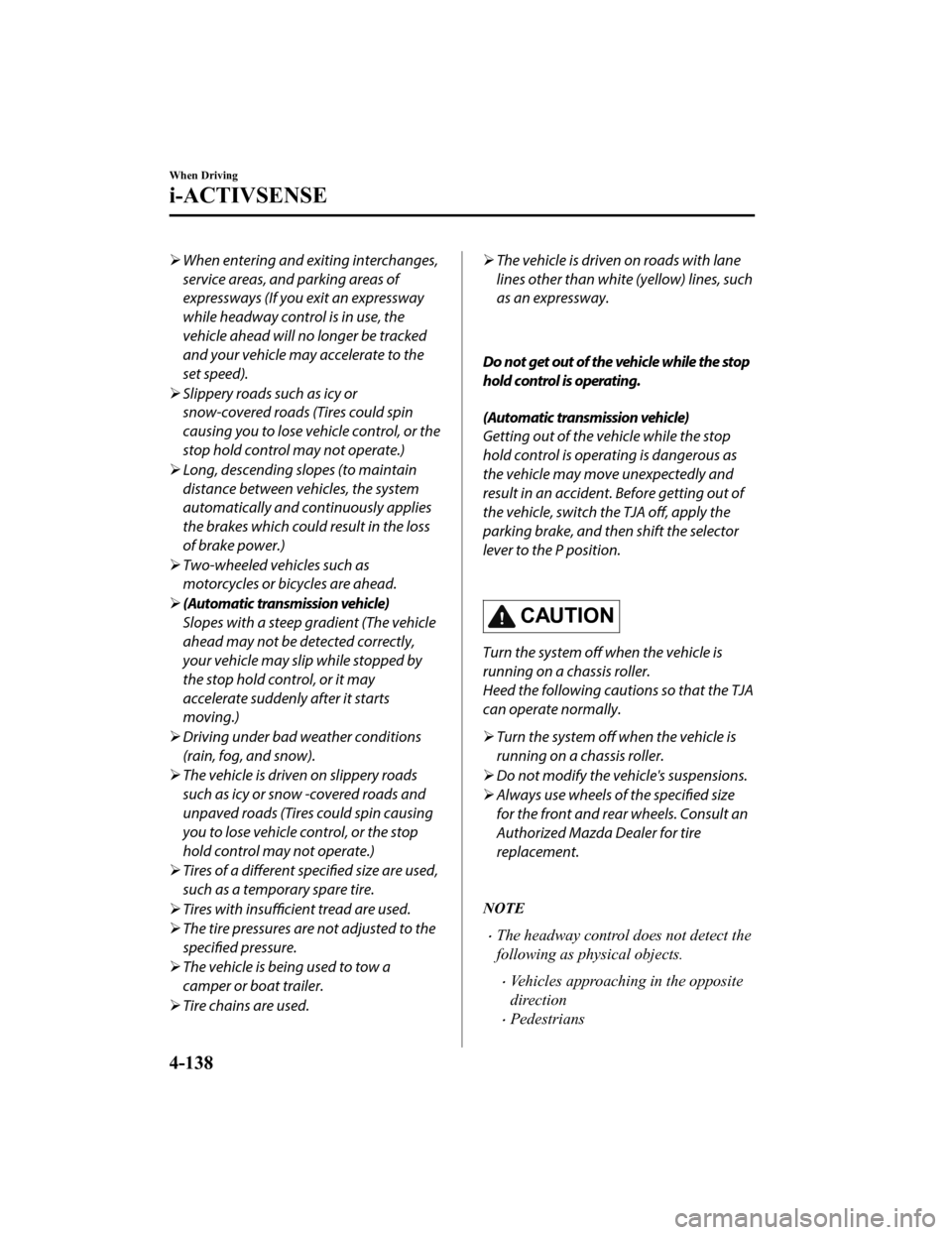
When entering and exiting interchanges,
service areas, and parking areas of
expressways (If you exit an expressway
while headway control is in use, the
vehicle ahead will no longer be tracked
and your vehicle may accelerate to the
set speed).
Slippery roads such as icy or
snow-covered roads (Tires could spin
causing you to lose vehicle control, or the
stop hold control may not operate.)
Long, descending slopes (to maintain
distance between vehicles, the system
automatically and continuously applies
the brakes which could result in the loss
of brake power.)
Two-wheeled vehicles such as
motorcycles or bicycles are ahead.
(Automatic transmission vehicle)
Slopes with a steep gradient (The vehicle
ahead may not be detected correctly,
your vehicle may slip while stopped by
the stop hold control, or it may
accelerate suddenly after it starts
moving.)
Driving under bad weather conditions
(rain, fog, and snow).
The vehicle is driven on slippery roads
such as icy or snow -covered roads and
unpaved roads (Tires could spin causing
you to lose vehicle control, or the stop
hold control may not operate.)
Tires of a different specified size are used,
such as a temporary spare tire.
Tires with insufficient tread are used.
The tire pressures are not adjusted to the
specified pressure.
The vehicle is being used to tow a
camper or boat trailer.
Tire chains are used.The vehicle is driven on roads with lane
lines other than white (yellow) lines, such
as an expressway.
Do not get out of the vehicle while the stop
hold control is operating.
(Automatic transmission vehicle)
Getting out of the vehicle while the stop
hold control is operating is dangerous as
the vehicle may move unexpectedly and
result in an accident. Before getting out of
the vehicle, switch the TJA off, apply the
parking brake, and then shift the selector
lever to the P position.
CAUTION
Turn the system off when the vehicle is
running on a chassis roller.
Heed the following cautions so that the TJA
can operate normally.
Turn the system off when the vehicle is
running on a chassis roller.
Do not modify the vehicle's suspensions.
Always use wheels of the specified size
for the front and rear wheels. Consult an
Authorized Mazda Dealer for tire
replacement.
NOTE
The headway control does not detect the
following as physical objects.
Vehicles approaching in the opposite
direction
Pedestrians
When Driving
i-ACTIVSENSE
4-138
Mazda3_8HZ1-EA-19G_Edition1_old 2019-5-17 13:49:03
Page 296 of 598
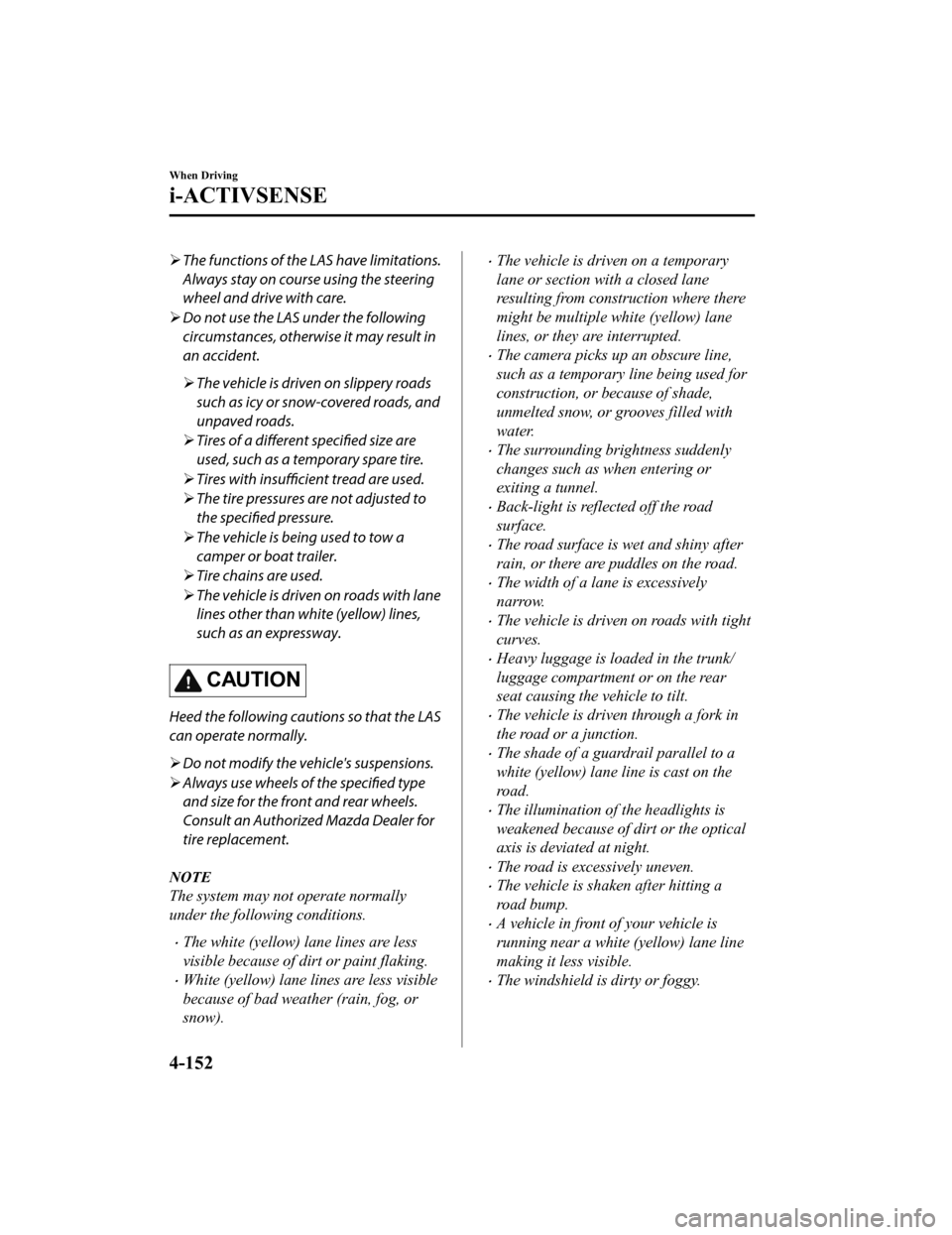
The functions of the LAS have limitations.
Always stay on course using the steering
wheel and drive with care.
Do not use the LAS under the following
circumstances, otherwise it may result in
an accident.
The vehicle is driven on slippery roads
such as icy or snow-covered roads, and
unpaved roads.
Tires of a different specified size are
used, such as a temporary spare tire.
Tires with insufficient tread are used.
The tire pressures are not adjusted to
the specified pressure.
The vehicle is being used to tow a
camper or boat trailer.
Tire chains are used.
The vehicle is driven on roads with lane
lines other than white (yellow) lines,
such as an expressway.
CAUTION
Heed the following cautions so that the LAS
can operate normally.
Do not modify the vehicle's suspensions.
Always use wheels of the
specified type
and size for the front and rear wheels.
Consult an Authorized Mazda Dealer for
tire replacement.
NOTE
The system may not operate normally
under the following conditions.
The white (yellow) lane lines are less
visible because of dirt or paint flaking.
White (yellow) lane lines are less visible
because of bad weather (rain, fog, or
snow).
The vehicle is driven on a temporary
lane or section with a closed lane
resulting from construction where there
might be multiple white (yellow) lane
lines, or they are interrupted.
The camera picks up an obscure line,
such as a temporary line being used for
construction, or because of shade,
unmelted snow, or grooves filled with
water.
The surrounding brightness suddenly
changes such as when entering or
exiting a tunnel.
Back-light is reflected off the road
surface.
The road surface is wet and shiny after
rain, or there are puddles on the road.
The width of a lane is excessively
narrow.
The vehicle is driven on roads with tight
curves.
Heavy luggage is loaded in the trunk/
luggage compartment or on the rear
seat causing the vehicle to tilt.
The vehicle is driven through a fork in
the road or a junction.
The shade of a guardrail parallel to a
white (yellow) lane line is cast on the
road.
The illumination of the headlights is
weakened because of dirt or the optical
axis is deviated at night.
The road is excessively uneven.
The vehicle is shaken after hitting a
road bump.
A vehicle in front of your vehicle is
running near a white (yellow) lane line
making it less visible.
The windshield is dirty or foggy.
When Driving
i-ACTIVSENSE
4-152
Mazda3_8HZ1-EA-19G_Edition1_old 2019-5-17 13:49:03
Page 302 of 598

Do not apply a sticker to a rear
ultrasonic sensor and rear camera.
Otherwise, the rear ultrasonic sensor
and rear camera may not be able to
detect vehicles or obstructions which
could result in an accident.
Do not disassemble a rear ultrasonic
sensor and rear camera.
If cracks or damage caused by flying
gravel or debris is visible around a rear
ultrasonic sensor and rear camera,
stop using the SBS-R system
immediately and have your vehicle
inspected by an Authorized Mazda
Dealer. If the vehicle continues to be
driven with cracks or scratch marks left
around an ultrasonic sensor, the
system may operate unnecessarily and
cause an unexpected accident.
Refer to Stopping the Smart Brake
Support [Rear] (SBS-R) System
Operation on page 4-160.
Consult an Authorized Mazda Dealer
for rear bumper replacement.
Do not modify the suspension:
If the vehicle height or inclination is
changed, the SBS-R system may not
operate correctly because it cannot detect
obstructions correctly.Do not apply a strong force to a rear
ultrasonic sensor and rear camera:
When washing the vehicle, do not spray
highly pressurized water against a rear
ultrasonic sensor and rear camera, or rub it
strongly. In addition , do not hit the rear
bumper forcefully when loading and
unloading cargo Otherwise, the sensors
may not detect obstructions correctly
which could cause the SBS-R system to not
operate normally, or it could operate
unnecessarily.
CAUTION
When driving
off-road in areas where
there is grass or foliage, it is
recommended that the SBS-R system be
turned off.
Always use tires of the specified size and
the same manufacturer, brand, and
tread pattern on all 4 wheels. In addition,
do not use tires with significantly
different wear patterns on the same
vehicle. Otherwise, the SBS-R system may
not operate normally.
If ice or snow is stuck on the rear
ultrasonic sensor and rear camera they
may not be able to detect obstructions
correctly depending on the conditions. In
such cases, the system may not be able
to perform controls correctly. Always
drive carefully and pay attention to the
rear of the vehicle.
When Driving
i-ACTIVSENSE
4-158
Mazda3_8HZ1-EA-19G_Edition1_old 2019-5-17 13:49:03
Page 306 of 598

SBS-RC operation
1. The SBS-RC system operates when theshift lever (manual transmission) or the
selector lever (automatic transmission)
is shifted to the reverse (R) position.
2. If there is the possibility of a collision with an approaching vehicle, the
SBS-RC system applies brake and
displays “BRAKE!” on the active
driving display and the
multi-information display.
WA R N I N G
Always check the surrounding area visually
before actually putting the vehicle in
reverse:
The system is only designed to assist you in
backing out of the lot when putting the
vehicle in reverse. Due to certain limitations
with the operation of this system, the
SBS-RC system may not operate brake or it
might be delayed even though a vehicle is
behind your vehicle. Always make it your
responsibility as a driver to check the rear.
Do not rely completely on the SBS-RC
system:
The SBS-RC system is only designed to
reduce damage in the event of a
collision. Over reliance on the system
leading to the accelerator pedal or brake
pedal being mistakenly operated could
result in an accident.
The SBS-RC system operates in response
to a vehicle. The system does not operate
in response to obstructions such as a
wall, pedestrians, 2-wheeled vehicles, or
animals.
To assure the correct operation of the
SBS-RC, heed the following cautions.
Do not apply a sticker to a rear radar and
rear camera. Otherwise, the rear radar
and rear camera may not be able to
detect vehicles or obstructions which
could result in an accident.
Do not disassemble a rear radar and rear
camera.
If cracks or damage caused by flying
gravel or debris is visible around a rear
radar and rear camera, stop using the
SBS-RC system immediately and have
your vehicle inspected by an Authorized
Mazda Dealer. If the vehicle continues to
be driven with cracks or scratch marks
left around an ultrasonic sensor, the
system may operate unnecessarily and
cause an unexpected accident.
Refer to Stopping the Smart Brake
Support [Rear Crossing] (SBS-RC) System
Operation on page 4-165.
Consult an Authorized Mazda Dealer for
rear bumper replacement.
Do not modify the suspension:
If the vehicle height or inclination is
changed, the SBS-RC system may not
operate correctly because it cannot detect
obstructions correctly.
When Driving
i-ACTIVSENSE
4-162
Mazda3_8HZ1-EA-19G_Edition1_old 2019-5-17 13:49:03
Page 312 of 598
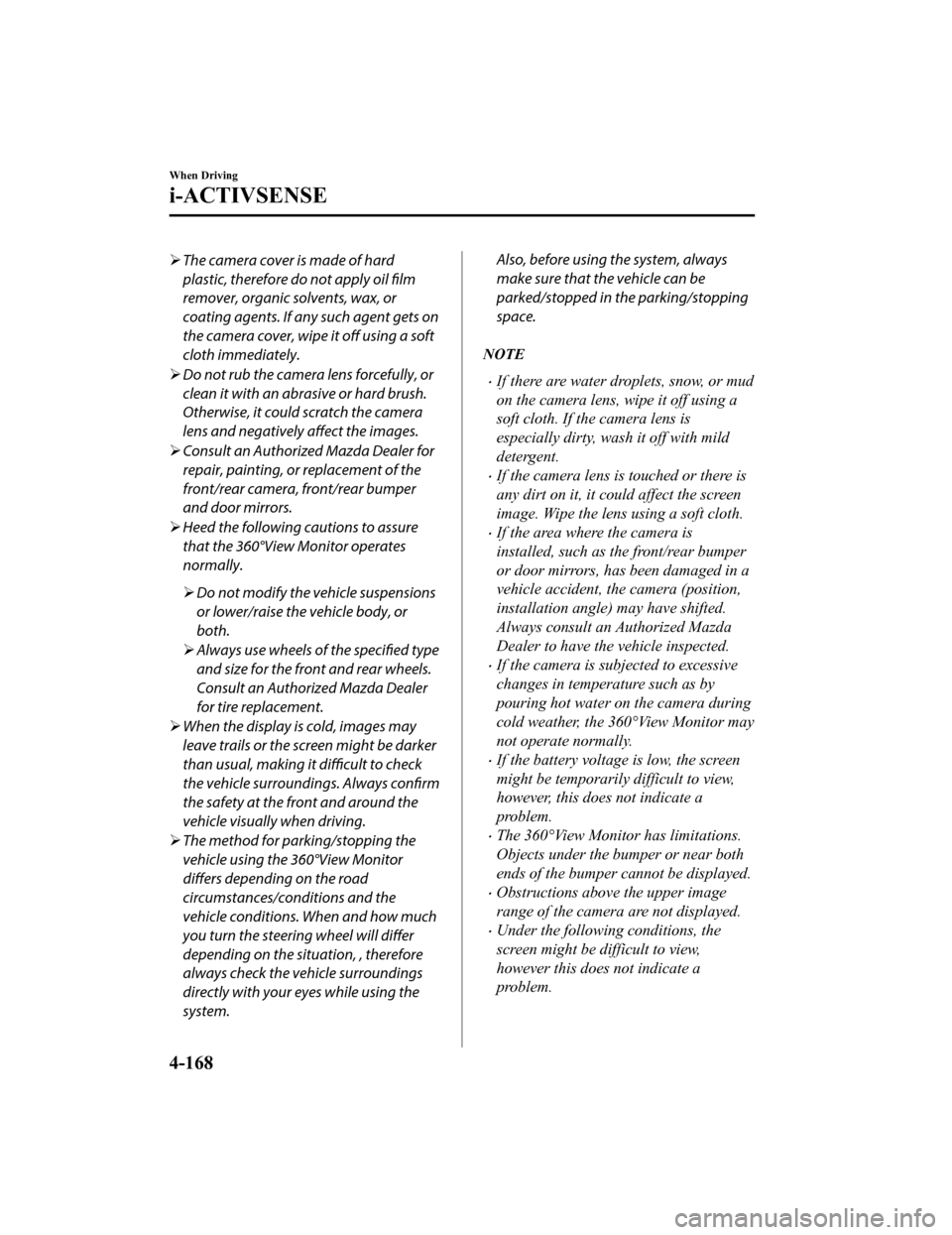
The camera cover is made of hard
plastic, therefore do not apply oil film
remover, organic solvents, wax, or
coating agents. If any such agent gets on
the camera cover, wipe it
off using a soft
cloth immediately.
Do not rub the camera lens forcefully, or
clean it with an abrasive or hard brush.
Otherwise, it could scratch the camera
lens and negatively affect the images.
Consult an Authorized Mazda Dealer for
repair, painting, or replacement of the
front/rear camera, front/rear bumper
and door mirrors.
Heed the following cautions to assure
that the 360°View Monitor operates
normally.
Do not modify the vehicle suspensions
or lower/raise the vehicle body, or
both.
Always use wheels of the
specified type
and size for the front and rear wheels.
Consult an Authorized Mazda Dealer
for tire replacement.
When the display is cold, images may
leave trails or the screen might be darker
than usual, making it
difficult to check
the vehicle surroundings. Always confirm
the safety at the front and around the
vehicle visually when driving.
The method for parking/stopping the
vehicle using the 360°View Monitor
differs depending on the road
circumstances/conditions and the
vehicle conditions. When and how much
you turn the steering wheel will differ
depending on the situation, , therefore
always check the vehicle surroundings
directly with your eyes while using the
system.Also, before using the system, always
make sure that the vehicle can be
parked/stopped in the parking/stopping
space.
NOTE
If there are water droplets, snow, or mud
on the camera lens, wipe it off using a
soft cloth. If the camera lens is
especially dirty, wash it off with mild
detergent.
If the camera lens is touched or there is
any dirt on it, it could affect the screen
image. Wipe the lens using a soft cloth.
If the area where the camera is
installed, such as the front/rear bumper
or door mirrors, has been damaged in a
vehicle accident, the camera (position,
installation angle) may have shifted.
Always consult an Authorized Mazda
Dealer to have the vehicle inspected.
If the camera is subjected to excessive
changes in temperature such as by
pouring hot water on the camera during
cold weather, the 360°View Monitor may
not operate normally.
If the battery voltage is low, the screen
might be temporarily difficult to view,
however, this does not indicate a
problem.
The 360°View Monitor has limitations.
Objects under the bumper or near both
ends of the bumper cannot be displayed.
Obstructions above the upper image
range of the camera are not displayed.
Under the following conditions, the
screen might be difficult to view,
however this does not indicate a
problem.
When Driving
i-ACTIVSENSE
4-168
Mazda3_8HZ1-EA-19G_Edition1_old 2019-5-17 13:49:03
Page 344 of 598

Forward Sensing Camera(FSC)
*
▼Forward Sensing Camera (FSC)
Your vehicle is equipped with a Forward
Sensing Camera (FSC). The Forward
Sensing Camera (FSC) is positioned near
the rearview mirro
r and used by the
following systems.
High Beam Control System (HBC)
Lane Departure Warning System
(LDWS)
Traffic Sign Recognition System (TSR)
Distance & Speed Alert (DSA)
Driver Attention Alert (DAA)
Driver Monitoring (DM)
Mazda Radar Cruise Control (MRCC)
Mazda Radar Cruise Control with Stop
& Go function (MRCC with Stop & Go
function)
Lane-keep Assist System (LAS)
Traffic Jam Assist (TJA)
Smart Brake Support (SBS)
1. Forward Sensing Camera (FSC)
The Forward Sensing Camera (FSC)
determines the conditions ahead of the
vehicle while traveling at night and detects
traffic lanes. The distance in which the
Forward Sensing Camera (FSC) can detect
objects varies depending on the
surrounding conditions.
WA R N I N G
Do not modify the suspension:
If the vehicle height or inclination is
changed, the system will not be able to
correctly detect vehicles ahead. This will
result in the system not operating normally
or mistakenly operating, which could cause
a serious accident.
CAUTION
Do not apply accessories, stickers or film
to the windshield near the Forward
Sensing Camera (FSC).
If the area in front of the Forward
Sensing Camera (FSC) lens is obstructed,
it will cause the system to not operate
correctly. Consequently, each system
may not operate normally which could
lead to an unexpected accident.
Do not disassemble or modify the
Forward Sensing Camera (FSC).
Disassembly or modification of the
Forward Sensing Camera (FSC) will cause
a malfunction or mistaken operation.
Consequently, each system may not
operate normally which could lead to an
unexpected accident.
Heed the following cautions to assure
the correct operation of the Forward
Sensing Camera (FSC).
When Driving
i-ACTIVSENSE
4-200*Some models.
Mazda3_8HZ1-EA-19G_Edition1_old 2019-5-17 13:49:03
Page 349 of 598
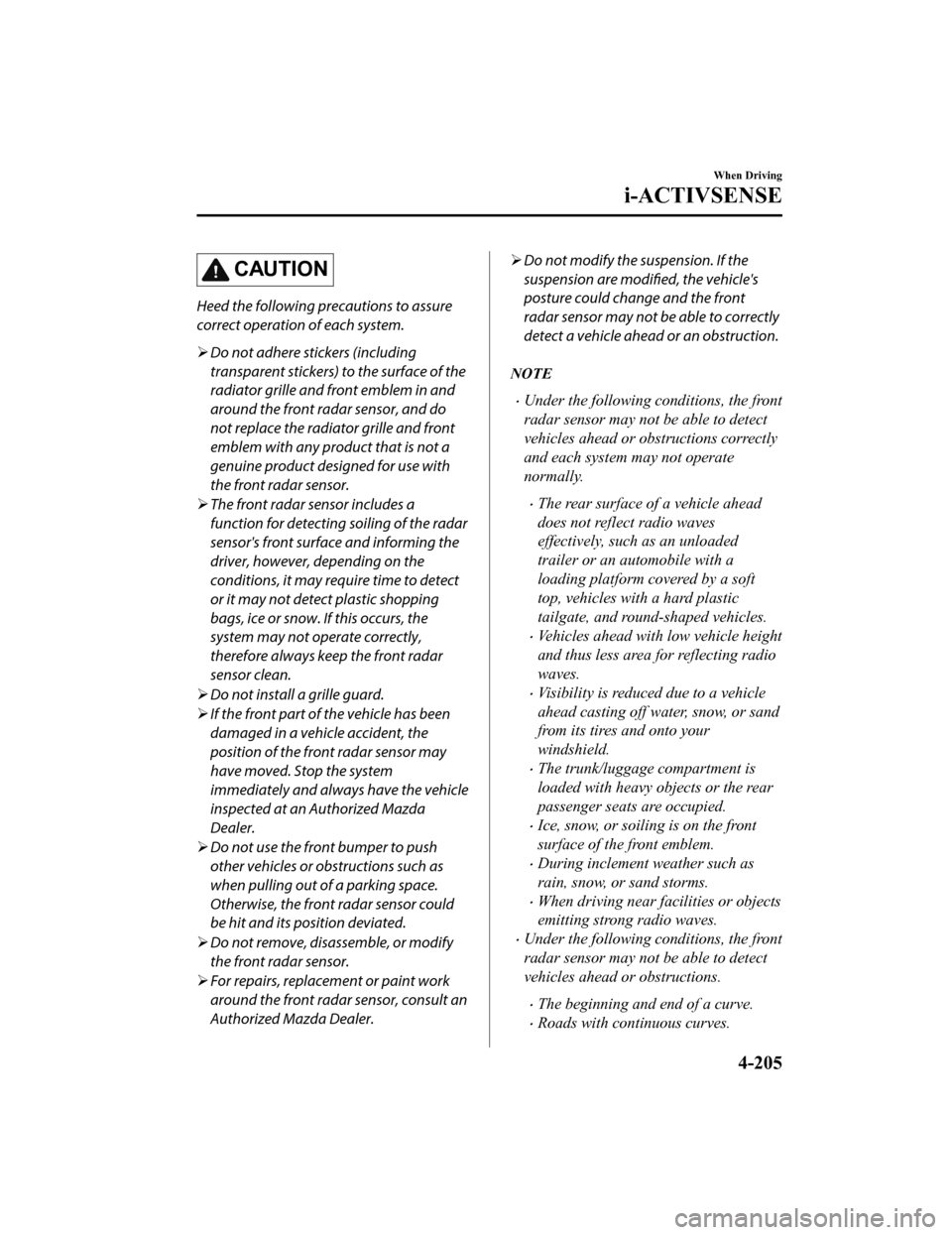
CAUTION
Heed the following precautions to assure
correct operation of each system.
Do not adhere stickers (including
transparent stickers) to the surface of the
radiator grille and front emblem in and
around the front radar sensor, and do
not replace the radiator grille and front
emblem with any product that is not a
genuine product designed for use with
the front radar sensor.
The front radar sensor includes a
function for detecting soiling of the radar
sensor's front surface and informing the
driver, however, depending on the
conditions, it may require time to detect
or it may not detect plastic shopping
bags, ice or snow. If this occurs, the
system may not operate correctly,
therefore always keep the front radar
sensor clean.
Do not install a grille guard.
If the front part of the vehicle has been
damaged in a vehicle accident, the
position of the front radar sensor may
have moved. Stop the system
immediately and always have the vehicle
inspected at an Authorized Mazda
Dealer.
Do not use the front bumper to push
other vehicles or obstructions such as
when pulling out of a parking space.
Otherwise, the front radar sensor could
be hit and its position deviated.
Do not remove, disa ssemble, or modify
the front radar sensor.
For repairs, replacement or paint work
around the front radar sensor, consult an
Authorized Mazda Dealer.
Do not modify the suspension. If the
suspension are modified, the vehicle's
posture could change and the front
radar sensor may not be able to correctly
detect a vehicle ahead or an obstruction.
NOTE
Under the following co nditions, the front
radar sensor may not be able to detect
vehicles ahead or obstructions correctly
and each system may not operate
normally.
The rear surface of a vehicle ahead
does not reflect radio waves
effectively, such as an unloaded
trailer or an automobile with a
loading platform covered by a soft
top, vehicles with a hard plastic
tailgate, and round-shaped vehicles.
Vehicles ahead with low vehicle height
and thus less area for reflecting radio
waves.
Visibility is reduced due to a vehicle
ahead casting off water, snow, or sand
from its tires and onto your
windshield.
The trunk/luggage compartment is
loaded with heavy objects or the rear
passenger seats are occupied.
Ice, snow, or soiling is on the front
surface of the front emblem.
During inclement weather such as
rain, snow, or sand storms.
When driving near facilities or objects
emitting strong radio waves.
Under the following co nditions, the front
radar sensor may not be able to detect
vehicles ahead or obstructions.
The beginning and end of a curve.
Roads with continuous curves.
When Driving
i-ACTIVSENSE
4-205
Mazda3_8HZ1-EA-19G_Edition1_old 2019-5-17 13:49:03